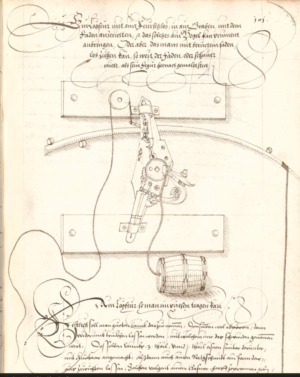I’m steadily working my way through more military handbooks from the late 1500s when there appears to have been a lot of revolutionary thought going into military technology and explosive device development in particular. My previous post on a grenade was dated 1578, you may recall that Giambelli’s ship explosive device was 1584, and I’ve written before about a postal device in the city of Pskov in 1581. I’ve also written before how “gun-locks” were used as initiating devices for explosives over a 250 year period.
On that latter point I’ve just found a gun lock (in this case a wheel-lock) drawn in a manuscript from Germany, dated 1582. The drawing is here and as you can see the design is very clear.

The wheel-lock was a progenitor of the flintlock which came in a few years later, in about 1600. In a wheel-lock a spring-loaded wheel spins against some pyrites held in the cock. Here you can see how the gun lock has been removed from a firearm and fastened to a frame. A string is attached to the trigger, led around a pulley and away to the person initiating the device. When the target presents itself, the person pulls the string, which pulls the trigger. On pulling the trigger a spring mechanism spins the steel wheel against the pyrites held in the cock. This causes sparks which ignites the fuse. The fuse leads to a barrel of gunpowder hidden nearby. In a post a few years ago I have an image showing a multiple IED attacks against a military convoy employing these exact devices, so it’s good to corroborate the attack with a contemporary IED design.
So, this is another example of how explosive device design appears to have developed rapidly at this peculiar point in history, across Europe. I think it is the publication of these handbooks and manuals of military science that seems to be helping – bu I’m afraid I’m not a good enough historian to identify other causes of this bubble of ideas. Comments from proper historians welcome!
A couple of follow-up thoughts:
1. The “pull string” could of course be adapted to a trip string, turning the command-initiated device into a victim-operated booby trap.
2. One possibility of the sudden uptick in apparent use of explosive devices at this point in history is manufacturing technology. I wonder of clock-making saw similar technological leaps at this time. Wheel-locks were invented in the early part of the century but are quite complex in design from an engineering and manufacturing perspective. Perhaps clock making manufacture and design took parallel leaps at this time and the transfer of ideas to wheel locks (essentially a clockwork mechanism, with a wheel powered by a spring) enabled cheaper device components and they became more commonly available rather than the early wheel locks which were the weapons of the rich. I’ve just read that coiled carbon steel spring (essential for wheel locks) was first made possible in the early 1500s – perhaps manufacture became easier in the 1570s, allowing them to be more easily and cheaply manufactured, and hence available for regular soldier’s weapons and “one-time use” in explosive devices. Perhaps the wheel lock mechanisms, like in the diagram above, were separated from the main charge and were thus in theory recoverable after the event.
